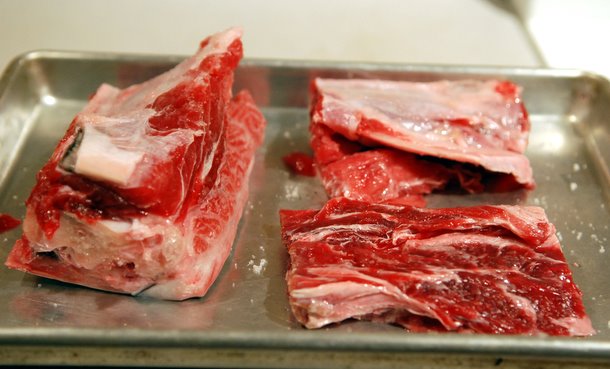Roasted Tuna Collar
Discover the exceptional flavors of tuna collar and learn how to prepare and cook this unique piece of fish. Find out why developing a relationship with your local fishmonger is the key to getting your hands on this delightful cut of fish for a delicious culinary experience.
Here's why you need to befriend your local fishmonger, and fast: Tuna collar. Chef Ono of Matsuri and I donned hair nets and white smocks to visit a fish wholesaler located beside Newark Airport yesterday. We arrived at the pristine facility at 5am to watch the inflow of seafood from around the globe. The highlight: A 650-pound, fresh, line-caught wild Blue Fin tuna, trucked down from a Massachusetts fishing port. Two men deftly portioned this magnificent fish into four loins, each destined for a local restaurant, a process that I'll be writing about soon. When we returned to Matsuri, a surprise -- the company sent the chef a piece of tuna collar with the loin he purchased. Chef Ono graciously handed me a foot and half chunk to cook at home.
While here in America we typically eat fish as boneless filets, I've learned that in Japan it's more often enjoyed on the bone, and for good reason. Like a T-bone in a steak, bones in fish impart incredible flavor to the flesh. And there's another reason fish on the bone is popular in Japan: chopsticks. Chopsticks are extremely precise instruments that can pick out morsels of food a clunky fork could never reach, like, around bones! With chopsticks, eating fish on the bone is a joy.
Okay, back to the tuna collar. This is one piece of fish you can never find at the fish store, unfortunately. But, remember the fishmonger? If he or she sells sashimi grade tuna, the shop has a connection to a fish wholesaler, of course, and can order a piece of tuna collar for you. Give it a try. The collar the chef gave me was almost steak-like (see the "before" photo below). A layer of fat lined the leathery skin, then came a layer of toro, then ruby red maguro against the thick bone. Amazing. Here's how I cooked it:
- Preheat oven to highest temperature for at least 10 minutes
- Hack tuna collar into manageable pieces -- this I did with a heavy cleaver, but it wasn't easy
- Salt the tuna collar (I use arajio, minerally, "wet" Japanese sea salt)
- When the oven is hot, broil the tuna collar for 5 minutes to caramelize the flesh
- Now stick it in the oven at 500 degrees for 15 more minutes
- Serve with yuzu kosho and daikon oroshi (fresh grated daikon)
The tuna collar was wonderful, from the crispy outside to the tender, almost raw flesh hiding in the deepest crevices of the bone, with delicious salt-baked tuna in between. The yuzu kosho, a peppery/citrusy condiment, stood up to the richness of the tuna while the grated daikon cut the oiliness.
I urge you to try baking tuna collar if you can get your hands on one. Yellow tail collar and salmon collar work wonderfully, too.

